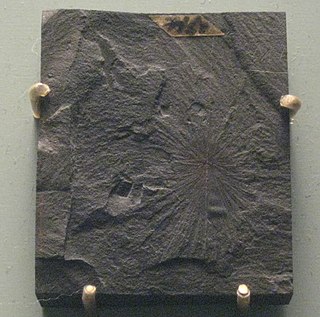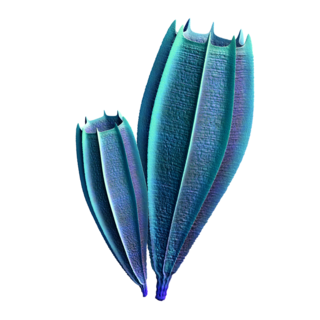
Choia is a genus of extinct demosponge ranging from the Cambrian until the Lower Ordovician periods. Fossils of Choia have been found in the Burgess Shale in British Columbia; the Maotianshan shales of China; the Wheeler Shale in Utah; and the Lower Ordovician Fezouata formation. It was first described in 1920 by Charles Doolittle Walcott.

Leanchoilia is a megacheiran arthropod known from Cambrian deposits of the Burgess Shale in Canada and the Chengjiang biota of China.

Chancelloria is a genus of early animals known from the Middle Cambrian Burgess Shale, the Comley limestone, the Wheeler Shale, the Bright Angel Shale and elsewhere. It is named after Chancellor Peak. It was first described in 1920 by Charles Doolittle Walcott, who regarded them as one of the most primitive groups of sponges. However, they are currently thought to be member of the group Chancelloriidae. 178 specimens of Chancelloria are known from the Greater Phyllopod bed, where they comprise 0.34% of the community.
A number of assemblages bear fossil assemblages similar in character to that of the Burgess Shale. While many are also preserved in a similar fashion to the Burgess Shale, the term "Burgess Shale-type fauna" covers assemblages based on taxonomic criteria only.
Crumillospongia is a genus of middle Cambrian sponges known from the Burgess Shale and other localities from the Lower and Middle Cambrian. Its name is derived from the Latin crumilla and spongia ("sponge"), a reflection of its similarity to a small leathery money purse. That is, it has a saclike shape, and its wall has holes of two sizes, with a well-developed internal canal system. 49 specimens of Crumillospongia are known from the Greater Phyllopod bed, where they comprise 0.1% of the community.

Liangshanella is a genus of Cambrian bradoriid known from the Chengjiang biota and Burgess Shale. 6263 specimens of Liangshanella are known from the Greater Phyllopod bed, where they comprise 11.9% of the community.

Morania is a genus of cyanobacterium preserved as carbonaceous films in the Middle Cambrian Burgess Shale. it is present throughout the shale; 2580 specimens of Morania are known from the Greater Phyllopod bed, where they comprise 4.90% of the community. It is filamentous, forms sheets, and resembles the modern cyanobacterium Nostoc. It would have had a role in binding the sediment, and would have been a food source for such organisms as Odontogriphus and Wiwaxia.

Takakkawia is a genus of sponge in the order Protomonaxonida and the family Takakkawiidae. It is known from the Middle Cambrian Burgess Shale that reached around 4 cm in height. Its structure comprises four columns of multi-rayed, organic spicules that align to form flanges. The spicules form blade-like structures, ornamented with concentric rings.

Herpetogaster is an extinct cambroernid genus of animal from the Early Cambrian Chengjiang biota of China, Blang Formation of China, Pioche Formation of Nevada and Middle Cambrian Burgess Shale of Canada containing the species Herpetogaster collinsi and Herpetogaster haiyanensis.
Acrothyra gregaria is a species of gregarious brachiopod known from the Middle Cambrian Burgess Shale. 253 specimens of Acrothyra are known from the Greater Phyllopod bed, where they comprise 0.5% of the community.

Eiffelia is an extinct genus of sponges known from the Middle Cambrian Burgess Shale as well as several Early Cambrian small shelly fossil deposits. It is named after Eiffel Peak, which was itself named after the Eiffel Tower. It was first described in 1920 by Charles Doolittle Walcott. It belongs in the Hexactinellid stem group. 60 specimens of Eiffelia are known from the Greater Phyllopod bed, where they comprise 0.11% of the community.

Falospongia is a genus of sponge made up of radiating fronds, known from the Middle Cambrian Burgess Shale. Its name is derived from the Latin fala ("scaffold") and spongia ("sponge"), referring to the open framework of the skeleton. It superficially resembles Haplistion but is monaxial. 5 specimens of Falospongia are known from the Greater Phyllopod bed, where they comprise under 0.1% of the community.
Fieldospongia is a genus of sea sponge known from the Middle Cambrian Burgess Shale. Just five specimens of Fieldospongia are known from the Greater Phyllopod bed, where they comprise less than 0.1% of the community.

Halichondrites, sometimes mis-spelt Halicondrites is an extinct genus of sea sponge known from the Middle Cambrian Burgess Shale. 7 specimens of Halichondrites are known from the Greater Phyllopod bed, where they comprise < 0.1% of the community.
Hamptonia is an extinct genus of sea sponge known from the Middle Cambrian Burgess Shale and the Lower Ordovician Fezouata formation. It was first described in 1920 by Charles Doolittle Walcott. 48 specimens of Hamptonia are known from the Greater Phyllopod bed, where they comprise < 0.1% of the community.

Leptomitus is a genus of demosponge known from the Middle Cambrian Burgess Shale. Its name is derived from the Greek lept ("slender") and mitos ("thread"), referring to the overall shape of the sponge. 138 specimens of Leptomitus are known from the Greater Phyllopod bed, where they comprise 0.26% of the community.

Pagetia is a genus of small trilobite, assigned to the Eodiscinid family Pagetiidae and which had global distribution during the Middle Cambrian. The genus contains 55 currently recognized species, each with limited spatial and temporal ranges.

Pirania is an extinct genus of sea sponge known from the Middle Cambrian Burgess Shale and the Ordovician Fezouata formation. It is named after Mount St. Piran, a mountain situated in the Bow River Valley in Banff National Park, Alberta. It was first described in 1920 by Charles Doolittle Walcott. 198 specimens of Pirania are known from the Greater Phyllopod bed, where they comprise 0.38% of the community.
Wapkia is an extinct genus of sea sponge with radial sclerites, known from the Middle Cambrian Burgess Shale. It was first described in 1920 by Charles Doolittle Walcott. 32 specimens of Wapkia are known from the Greater Phyllopod bed, where they comprise 0.06% of the community.

Diagoniella is a genus of sponge known from the Middle Cambrian Burgess Shale. 128 specimens of Diagoniella are known from the Greater Phyllopod bed, where they comprise 0.24% of the community.













